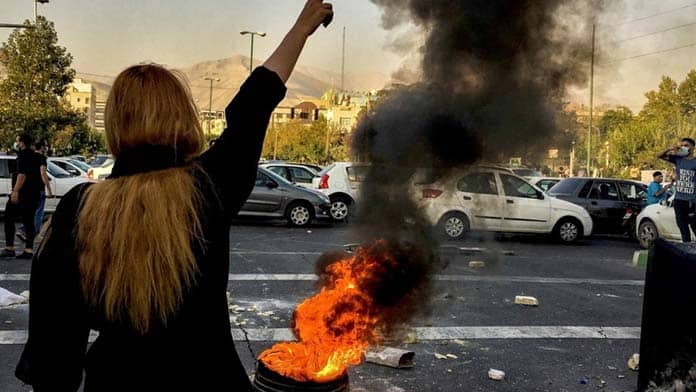Protests in Iran are still ramping up pressure on the regime, entering their third month despite a brutal crackdown by the state.
The protests have displayed incredible resilience and are now calling for the fall of the authoritarian Islamic Republic.
The regime is clearly under pressure. In early December Iran’s Prosecutor General Mohammad Jafar Montazeri said the hated “morality police” had been suspended. According to Al Jazeera, the white police vans of the morality police had not been seen patrolling the streets in the lead up to the statement. Many women no longer wear the headscarf when on the street.
He also reportedly said that the mandatory headscarf law was being reviewed. If confirmed this would be a significant concession to the movement.
But as yet there is no sign the morality police are fully or permanently disbanded. Before the protests began the regime had already promised to use facial recognition on public transport to police dress codes.
To seriously threaten the regime protests will have to grow and workers’ strikes will have to spread.
New wave of protest
The Prosecutor General’s comments came after a major three-day protest in mid-November coinciding with the anniversary of widespread protests in 2019. Three years ago, the state killed at least 1500 people during the “Bloody November” crackdown.
The protests last month included demands against poverty, price hikes and low wages. These echo the demands of the movement in 2019 that started over price increases, escalating into calls for the fall of the regime.
Street protests took place in at least 62 cities, in many cases involving battles with police, barricading streets and lighting fires on the barricades. Dozens were killed by live fire from state forces, who also hit protesters with a barrage of tear gas and mass arrests.
The November action was labelled a “general strike”. Mostly this meant small shopkeepers closed their businesses and students at several universities shut down classes. But significantly, metal workers in the city of Isfahan went on strike for the entire three days. The strike was about wages but was timed to coincide with the protests.
The protests were met with repression, which was particularly fierce in Kurdish areas. Military vehicles and the Islamic Revolutionary Guard Corps were deployed in large numbers to crush protests in the Kurdish city of Mahabad, a hotbed of dissent.
Video of heavy military equipment and weapons entering the city was posted on social media, as well as live fire in the streets and reports of several killings.
Protest and strikes continue
The end of November saw more strikes including at a car factory, a metal plant and a strike by truck drivers.
According to some reports the truck drivers’ strike in several cities lasted for three days. The strike was over fuel costs, but the Union of Truckers and Drivers Organisations says it was also against government repression, particularly in the provinces of Baluchistan, Kurdistan and Sistan.
Another strike broke out at the Iran tyre company in Tehran, where workers chanted “we are all together” and “death to the dictator.”
The metal workers in Isfahan who had earlier walked out for three days, struck again. They marched in their hundreds demanding higher wages. Workers at Bafaq steel plant were also reported to be on strike for health and safety following an explosion.
There were also reports of strikes at Sarma Afarin Company in the Alborz Industrial Complex and in the Pars Home Appliances Company, also in Alborz.
From the streets to the workplaces
More action by organised workers is essential if the movement is to build the power it needs to win. Oil workers’ strikes dealt the death-blow to the Western-backed dictator, the Shah, who was brought down in Iran’s 1979 revolution.
Up until now, workers’ action has been relatively limited and the core of the movement has been on the streets and in the universities. Before November there had been some teachers’ strikes as well as strikes by contract oil workers and others. But the permanent core workforce in the oil industry is yet to strike.
Another three-day protest began on 5 December in the lead-up to Iran’s Student Day on 7 December. The date marks the anniversary of the murder of three students in 1953 at the hands of the Shah’s police.
Inflation in Iran is soaring, and poverty continues to bite the workers of Iran. More, bigger protests and demands connecting economic discontent with calls for political freedom and an end to state repression can help spread the movement in the streets into the workplaces.
By Adam Adelpour






